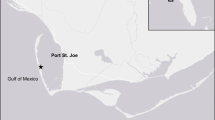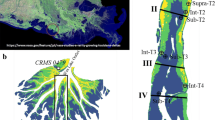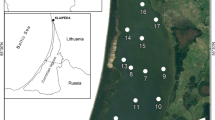Abstract
Dissolved organic carbon (DOC) flux dynamics were examined in the context of other biogeochemical cycles in intertidal sediments inhabited by benthic microalgae. In August 2003, gross oxygenic photosynthetic (GOP) rates, oxygen penetration depths, and benthic flux rates were quantified at seven sites along the Duplin River, GA, USA. Sediments contained abundant benthic microalgal (BMA) biomass with a maximum chlorophyll a concentration of 201 mg chl a m−2. Oxygen microelectrodes were used to determine GOP rates and O2 penetration depth, which were tightly correlated with light intensity. Baseline and 15N-nitrate amended benthic flux core incubations were employed to quantify benthic fluxes and to investigate the impact of BMA on sediment water exchange under nitrogen (N)-limited and N-replete conditions. Unamended sediments exhibited tight coupling between GOP and respiration and served as a sink for water column dissolved inorganic nitrogen (DIN) and a source of silicate and dissolved inorganic carbon (DIC). The BMA response to the N addition indicated sequential nutrient limitation, with N limitation followed by silicate limitation. In diel (light–dark) incubations, biological assimilation accounted for 83% to 150% of the nitrate uptake, while denitrification (DNF) and dissimilatory nitrate reduction to ammonium (DNRA) accounted for <7%; in contrast, under dark conditions, DNF and DNRA accounted for >40% of the NO3 − uptake. The N addition shifted the metabolic status of the sediments from a balance of autotrophy and heterotrophy to net autotrophy under diel conditions, and the sediments served as a sink for water column DIN, silicate, and DIC but became a source of DOC, suggesting that the increased BMA production was decoupled from sediment bacterial consumption of DOC.





Similar content being viewed by others
References
Admiraal, W., and H. Peletier. 1980. Influence of seasonal variation of temperature and light on the growth of cultures and natural populations of intertidal diatoms. Marine Ecology Progress Series 2: 35–43. doi:10.3354/meps002035.
Admiraal, W., H. Peletier, and T. Brouwer. 1984. The seasonal succession patterns of diatom species on an intertidal mudflat: an experimental analysis. Oikos 42: 30–40. doi:10.2307/3544606.
Admiraal, W., C. Riaux-Gobin, and R. Laane. 1987. Interactions of ammonium, nitrate, and D-and L-amino acids in the nitrogen assimilation of two species of estuarine benthic diatoms. Marine Ecology Progress Series 40: 267–273. doi:10.3354/meps040267.
Aleem, A. 1950. The diatom community inhabiting the mud-flats at Whitstable. New Phytologist 49: 174–188. doi:10.1111/j.1469-8137.1950.tb07503.x.
Allen, A., M. Booth, M. Frischer, P. Verity, J. Zehr, and S. Zani. 2001. Diversity and detection of nitrate assimilation genes in marine bacteria. Applied and Environmental Microbiology 67: 5343–5348. doi:10.1128/AEM.67.11.5343-5348.2001.
Aller, R., and L. Benninger. 1981. Spatial and temporal patterns of dissolved ammonium, manganese and silica fluxes from bottom sediments of Long Island Sound, USA. Journal of Marine Research 39: 295–314.
An, S., and W. Gardner. 2002. Dissimilatory nitrate reduction to ammonium (DNRA) as a nitrogen link, versus denitrification as a sink in a shallow estuary (Laguna Madre/Baffin Bay, Texas). Marine Ecology Progress Series 237: 41–50. doi:10.3354/meps237041.
Anderson, I., K. McGlathery, and A. Tyler. 2003. Microbial mediation of “reactive” nitrogen transformations in a temperate lagoon. Marine Ecology Progress Series 246: 73–84. doi:10.3354/meps246073.
Azam, F., T. Fenchel, J. Field, J. Gray, L. Meyer-Reil, and F. Thingstad. 1983. The ecological role of water-column microbes in the sea. Marine Ecology Progress Series 10: 257–263. doi:10.3354/meps010257.
Blackburn, T., and K. Henriksen. 1983. Nitrogen cycling in different types of sediments from Danish waters. Limnology and Oceanography 28: 477–493.
Cabrita, M., and V. Brotas. 2000. Seasonal variation in denitrification and dissolved nitrogen fluxes in intertidal sediments of the Tagus estuary, Portugal. Marine Ecology Progress Series 202: 51–65. doi:10.3354/meps202051.
Canfield, D., and D. Des Marais. 1993. Biogeochemical cycles of carbon, sulfur, and free oxygen in a microbial mat. Geochimica et Cosmochimica Acta 57: 3971–3984. doi:10.1016/0016-7037(93)90347-Y.
Clavier, J., G. Boucher, L. Chauvaud, R. Fichez, and S. Chifflet. 2005. Benthic response to ammonium pulses in a tropical lagoon: implications for coastal environmental processes. Journal of Experimental Marine Biology and Ecology 316: 231–241. doi:10.1016/j.jembe.2004.11.004.
Cline, J. 1969. Spectrophotometric determination of hydrogen sulfide in natural waters. Limnology and Oceanography 14: 454–458.
Cook, P., A. Revill, E. Butler, and B. Eyre. 2004. Carbon and nitrogen cycling on intertidal mudflats of a temperate Australian estuary. II. Nitrogen cycling. Marine Ecology Progress Series 280: 39–54. doi:10.3354/meps280039.
Dalsgaard, T. 2003. Benthic primary production and nutrient cycling in sediments with benthic microalgae and transient accumulation of macroalgae. Limnology and Oceanography 48: 2138–2150.
Darley, W., C. Montague, F. Plumley, W. Sage, and A. Psalidas. 1981. Factors limiting edaphic algal biomass and productivity in a Georgia salt marsh. Journal of Phycology 17: 122–128. doi:10.1111/j.0022-3646.1981.00122.x.
Decho, A. 1990. Microbial extracellular secretion in ocean environments: Their role in food webs and marine processes. Oceanography and Marine Biology: An Annual Review 28: 73–153.
Decho, A., and G. Lopez. 1993. Exopolymer microenvironments of microbial flora: multiple and interactive effects on trophic relationships. Limnology and Oceanography 38: 1633–1645.
de Jonge, V., and J. van Beusekom. 1995. Wind- and tide-induced resuspension of sediment and microphytobenthos from tidal flats in the Ems estuary. Limnology and Oceanography 40: 766–778.
Dizon, R., and H. Yap. 1999. Short-term responses of coral reef microphytobenthic communities to inorganic nutrient loading. Limnology and Oceanography 44: 1259–1267.
Doering, P., C. Oviatt, L. Beatty, V. Banzon, R. Rice, S. Kelly, B. Sullivan, and J. Frithsen. 1989. Structure and function in a model coastal ecosystem: silicon, the benthos, and eutrophication. Marine Ecology Progress Series 52: 287–299. doi:10.3354/meps052287.
Edgar, L., and J. Pickett-Heaps. 1984. Diatom locomotion. In Progress in phycological research, volume 3, eds. D. Chapman, , and F. Round, 48–88. Bristol: Biopress.
Eyre, B., S. Rysgaard, T. Dalsgaard, and P. Christensen. 2002. Comparison of isotope pairing and N2/Ar methods for measuring sediment denitrification rates —assumptions, modifications, and implications. Estuaries 25: 1077–1087.
Flint, R., and D. Kamykowski. 1984. Benthic nutrient regeneration in south Texas coastal waters. Estuarine Coastal and Shelf Science 18: 221–230. doi:10.1016/0272-7714(84)90108-2.
Goto, N., T. Kawamura, O. Mitamura, and H. Terai. 1999. Importance of extracellular organic carbon production in the total primary production by tidal-flat diatoms in comparison to phytoplankton. Marine Ecology Progress Series 190: 289–295. doi:10.3354/meps190289.
Hecky, R., and P. Kilham. 1988. Nutrient limitation of phytoplankton in freshwater and marine environments: A review of recent evidence on the effects of enrichment. Limnology and Oceanography 33: 796–822.
Heil, C., K. Chaston, A. Jones, P. Bird, B. Longstaff, S. Costanzo, and W. Dennison. 2004. Benthic microalgae in coral reef sediments of the southern Great Barrier Reef, Australia. Coral Reefs 23: 336–343. doi:10.1007/s00338-004-0390-1.
Hoagland, K., J. Rosowski, M. Gretz, and S. Roemer. 1993. Diatom extracellular polymeric substances: function, fine structure, chemistry, and physiology. Journal of Phycology 29: 537–566. doi:10.1111/j.0022-3646.1993.00537.x.
Hollibaugh, J. 1978. Nitrogen regeneration during the degradation of several amino acids by plankton communities collected near Hallifax, Nova Scotia, Canada. Marine Biology 45: 191–201. doi:10.1007/BF00390601.
Holmes, R., J. McClelland, D. Sigman, B. Fry, and B. Peterson. 1998. Measuring 15N-NH4 + in marine, estuarine, and fresh water: An adaptation of the ammonia diffusion method for samples with low ammonium concentrations. Marine Chemistry 60: 235–243. doi:10.1016/S0304-4203(97)00099-6.
Imberger, J., T. Berman, R. Christian, E. Sherr, D. Whitney, L. Pomeroy, R. Wiegert, and W. Wiebe. 1983. The influence of water motion on the distribution and transport of materials in a salt marsh estuary. Limnology and Oceanography 28: 201–214.
Jensen, L. 1984. Antimicrobial action of antibiotics on bacterial and algal carbon metabolism: on the use of antibiotics to estimate bacterial uptake of algal extracellular products (EOC). Archiv fur Hydrobiologie 99: 423–432.
Joye, W., and R. Lee. 2005. Benthic microbial mats: Important sources of fixed nitrogen and carbon to the Twin Cays, Belize ecosystem. Atoll Research Bulletin 528: 1925–1937.
Joye, S., and H. Paerl. 1993. Contemporaneous nitrogen fixation and denitrification in intertidal microbial mats: rapid response to runoff events. Marine Ecology Progress Series 94: 267–274.
Joye, S., M. Mazzotta, and J. Hollibaugh. 1996. Community metabolism in microbial mats: The occurrence of biologically-mediated iron and manganese reduction. Estuarine Coastal and Shelf Science 43: 747–766. doi:10.1006/ecss.1996.0101.
Joye, S., W. Porubsky, N. Weston, and R. Lee. 2003. Benthic microalgal production and nutrient dynamics in intertidal sediments. In BioGeoChemistry of Tidal Flats, Forschungszentrum Terramare Berichte Nr. 12, Proceedings of a Workshop held at the Hanse Institute of Advanced Study, ed. J. Rullkštter, 67–70. Delmenhorst, Germany, May 14–17 2003, ISSN 1432-797X.
Kana, T., M. Sullivan, J. Cornwell, and K. Groszkowski. 1998. Denitrification in estuarine sediments determined by membrane inlet mass spectrometry. Limnology and Oceanography 43: 334–339.
Kelderman, P., H. Lindeboom, and J. Klein. 1988. Effects of nutrient enrichment on microalgal community composition in a coastal shallow-water sediment system: an experimental study. Botanica Marina 34: 341–358.
Krom, M. 1991. Importance of benthic productivity in controlling the flux of dissolved inorganic nitrogen through the sediment–water interface in a hypertrophic marine ecosystem. Marine Ecology Progress Series 78: 163–172. doi:10.3354/meps078163.
Lomstein, B., A. Jensen, J. Hansen, J. Andreasen, L. Hansen, J. Berntsen, and H. Kunzendorf. 1998. Budgets of sediment nitrogen and carbon cycling in the shallow water of Knebel Vig, Denmark. Aquatic Microbial Ecology 14: 69–80. doi:10.3354/ame014069.
Marinelli, R. 1992. Effects of polychaetes on silicate dynamics and fluxes in sediments: Importance of species, animal activity and polychaete effects on benthic diatoms. Journal of Marine Research 50: 745–779.
McClelland, J., and I. Valiela. 1998. Linking nitrogen in estuarine producers to land-derived sources. Limnology and Oceanography 43: 577–585.
McClelland, J., I. Valiela, and R. Michener. 1997. Nitrogen-stable isotope signatures in estuarine food webs: A record of increasing urbanization in coastal watersheds. Limnology and Oceanography 42: 930–937.
McGlathery, K., K. Sundback, and I. Anderson. 2004. The importance of primary producers for benthic nitrogen and phosphorous cycling. In Estuarine nutrient cycling: the influence of primary producers, eds. S. Nielsen, , G. Banta, and M. Foldager, 231–262. Boston: Kluwer.
Middelburg, J., C. Barranguet, H. Boschker, P. Herman, T. Moens, and C. Heip. 2000. The fate of intertidal microphytobenthos carbon: An in situ 13C-labeling study. Limnology and Oceanography 45: 1224–1234.
Nielsen, L. 1992. Denitrification in sediment determined from nitrogen isotope pairing. FEMS Microbiology Ecology 86: 347–362. doi:10.1111/j.1574-6968.1992.tb04828.x.
Nilsson, P., B. Jönsson, I. Swanberg, and K. Sundbäck. 1991. Response of a marine shallow-water sediment system to an increased load of inorganic nutrients. Marine Ecology Progress Series 71: 275–290. doi:10.3354/meps071275.
Paerl, H. 1997. Coastal eutrophication and harmful algal blooms: Importance of atmospheric deposition and groundwater as “new” nitrogen and other nutrient sources. Limnology and Oceanography 42: 1154–1165.
Paerl, H., J. Bales, L. Ausley, C. Buzzelli, L. Crowder, L. Eby, J. Fear, M. Go, B. Peierls, T. Richardson, and J. Ramus. 2001. Ecosystem impacts of three sequential hurricanes (Dennis, Floyd, and Irene) on the United States’ largest lagoonal estuary, Pamlico Sound, NC. Proceedings of the National Academy of Science 98: 5655–5660.
Paerl, H., S. Joye, and M. Fitzpatrick. 1993. Evaluation of nutrient limitation of CO2 and N2 fixation in marine microbial mats. Marine Ecology Progress Series 101: 297–306.
Perkins, R., G. Underwood, V. Brotas, G. Snow, B. Jesus, and L. Ribeiro. 2001. Responses of microphytobenthos to light: primary production and carbohydrate allocation over an emersion period. Marine Ecology Progress Series 223: 101–112. doi:10.3354/meps223101.
Peterson, B., and R. Howarth. 1987. Sulfur, carbon, and nitrogen isotopes used to trace organic matter flow in the salt-marsh estuaries of Sapelo Island, Georgia. Limnology and Oceanography 32: 1195–1213.
Pinckney, J., and R. Zingmark. 1993a. Biomass and production of benthic microalgal communities in estuarine habitats. Estuaries 16: 887–897. doi:10.2307/1352447.
Pinckney, J., and R. Zingmark. 1993b. Modeling the annual production of intertidal benthic microalgae in estuarine ecosystems. Journal of Phycology 29: 396–407. doi:10.1111/j.1529-8817.1993.tb00140.x.
Pinckney, J., H. Paerl, and M. Fitzpatrick. 1995. Impacts of seasonality and nutrients on microbial mat community structure and function. Marine Ecology Progress Series 123: 207–216.
Pinckney, J., H. Paerl, P. Tester, and T. Richardson. 2001. The role of nutrient loading and eutrophication in estuarine ecology. Environmental Health Perspectives 109: 699–706. doi:10.2307/3454916.
Pomeroy, L. 1959. Algal productivity in salt marshes of Georgia. Limnology and Oceanography 4: 386–397.
Pomeroy, L., and J. Imberger. 1981. The physical and chemical environment. In The ecology of a salt marsh, eds. L. Pomeroy, , and R. Wiegert, 21–36. New York: Springer.
Pomeroy, L., W. Darley, E. Dunn, J. Gallagher, E. Haines, and D. Whitney. 1981. Primary production. In The ecology of a salt marsh, eds. L. Pomeroy, , and R. Wiegert, 39–67. New York: Springer.
Ragotzkie, R., and R. Bryson. 1955. Hydrography of the Duplin River, Sapelo Island, Georgia. Bulletin of Marine Science of the Gulf and Caribbean 5: 297–314.
Ragueneau, O., E. De Blas Varela, P. Treguer, B. Queguiner, and Y. Del Amo. 1994. Phytoplankton dynamics in relation to the biogeochemical cycle of silicon in a coastal ecosystem of western Europe. Marine Ecology Progress Series 43: 63–69.
Redfield, A. 1958. The biological control of chemical factors in the environment. American Scientist 46: 205–222.
Revsbech, N., and B. Jørgensen. 1983. Photosynthesis of benthic microflora measured with high spatial resolution by the oxygen microprofile method: Capabilities and limitations of the method. Limnology and Oceanography 28: 749–756.
Revsbech, N., J. Sørensen, T. Blackburn, and J. Lomholt. 1980. Distribution of oxygen in marine sediments measured with microelectrodes. Limnology and Oceanography 25: 403–411.
Revsbech, N., B. Jørgensen, T. Blackburn, and Y. Cohen. 1983. Microelectrode studies of photosynthesis and O2, H2S and pH profiles of a microbial mat. Limnology and Oceanography 28: 1062–1074.
Rysgaard, S., N. Risgaard-Petersen, L. Nielsen, and N. Revsbech. 1993. Nitrification and denitrification in lake and estuarine sediments measured by the 15N dilution technique and isotope pairing. Applied and Environmental Microbiology 59: 2093–2098.
Rysgaard, S., P. Christensen, and L. Nielsen. 1995. Seasonal variation in nitrification and denitrification in estuarine sediment colonized by benthic microalgae and bioturbating infauna. Marine Ecology Progress Series 126: 111–121. doi:10.3354/meps126111.
Sigmon, D., and L. Cahoon. 1997. Comparative effects of benthic microalgae and phytoplankton on dissolved silica fluxes. Aquatic Microbial Ecology 13: 275–284. doi:10.3354/ame013275.
Solorzano, L. 1969. Determination of ammonia in natural waters by the phenonlhypochlorite method. Limnology and Oceanography 14: 799–801.
Steward, J., R. Virnstein, M. Lasi, L. Morris, J. Miller, L. Hall, and W. Tweedale. 2006. The impacts of the 2004 hurricanes on hydrology, water quality, and seagrass in the central Indian River Lagoon, Florida. Estuaries and Coasts 296A: 954–965.
Strickland, J., and T. Parsons. 1972. A practical handbook of seawater analysis, 2nd ed. Bulletin of the Fisheries Research Board of Canada.
Sundareshwar, P., J. Morris, E. Koepfler, and B. Fornwalt. 2003. Phosphorous limitation of coastal ecosystem processes. Science 299: 563–565. doi:10.1126/science.1079100.
Sundbäck, K., and W. Granéli. 1988. Influence of microphytobenthos on nutrient fluxes between sediment and water: a laboratory continuous flow study. Marine Ecology Progress Series 43: 63–69. doi:10.3354/meps043063.
Taylor, I., D. Paterson, and A. Mehlert. 1999. The quantitative variability and monosaccharide composition of sediment carbohydrates associated with intertidal diatom assemblages. Biogeochemistry 45: 303–327.
Thornton, D., G. Underwood, and D. Nedwell. 1999. Effect of illumination and emersion period on the exchange of ammonium across the estuarine sediment–water interface. Marine Ecology Progress Series 184: 11–20. doi:10.3354/meps184011.
Tobias, C., A. Giblin, J. McClelland, J. Tucker, and B. Peterson. 2003. Sediment DIN fluxes and preferential recycling of benthic microalgal nitrogen in a shallow macrotidal estuary. Marine Ecology Progress Series 257: 25–36. doi:10.3354/meps257025.
Tupas, L., and I. Koike. 1990. Amino acid and ammonium utilization by heterotrophic marine bacteria grown in enriched seawater. Limnology and Oceanography 35: 1145–1155.
Tupas, L., and I. Koike. 1991. Simultaneous uptake and regeneration of ammonium by mixed assemblages of heterotrophic marine bacteria. Marine Ecology Progress Series 70: 273–282.
Underwood, G., and J. Kromkamp. 1999. Primary production by phytoplankton and microphytobenthos in estuaries. In Advances in ecological research: estuaries, vol. 29, eds. D. Nedwell, , and D. Raffaelli, 93–153. New York: Academic.
van Duyl, F., W. van Raaphorst, and A. Kop. 1993. Benthic bacterial production and nutrient sediment–water exchange in sandy North Sea sediments. Marine Ecology Progress Series 100: 85–95. doi:10.3354/meps100085.
Velasquez, L. 2005. Benthic primary production in coastal salt marsh systems. M.S. thesis. Univ. of Georgia.
Veuger, B., B. Eyre, D. Maher, and J. Middelburg. 2007. Nitrogen incorporation and retention by bacteria, algae, and fauna in a subtropical intertidal sediment: An in situ 15N-labeling study. Limnology and Oceanography 52: 1930–1942.
Wetz, M., and P. Wheeler. 2007. Release of dissolved organic matter by coastal diatoms. Limnology and Oceanography 52: 798–807.
Williams, R. 1962. The ecology of diatom populations in a Georgia salt marsh. Ph. D. thesis. Harvard Univ.
Williams, R. 1963. The use of netting to collect motile benthic algae. Limnology and Oceanography 8: 360–361.
Acknowledgements
We thank M. Erickson, M. Price, and N. Weston for assistance in the field and in the laboratory; and I. Anderson, N. Weston, T. Hollibaugh, E. Howard, R. Jahnke and two anonymous reviewers for providing comments that substantially improved this paper. This research was supported by the National Science Foundation’s Georgia Coastal Ecosystems Long Term Ecological Research Program (OCE 99-82133 and OCE 06-20959).
Author information
Authors and Affiliations
Corresponding author
Rights and permissions
About this article
Cite this article
Porubsky, W.P., Velasquez, L.E. & Joye, S.B. Nutrient-Replete Benthic Microalgae as a Source of Dissolved Organic Carbon to Coastal Waters. Estuaries and Coasts 31, 860–876 (2008). https://doi.org/10.1007/s12237-008-9077-0
Received:
Revised:
Accepted:
Published:
Issue Date:
DOI: https://doi.org/10.1007/s12237-008-9077-0




